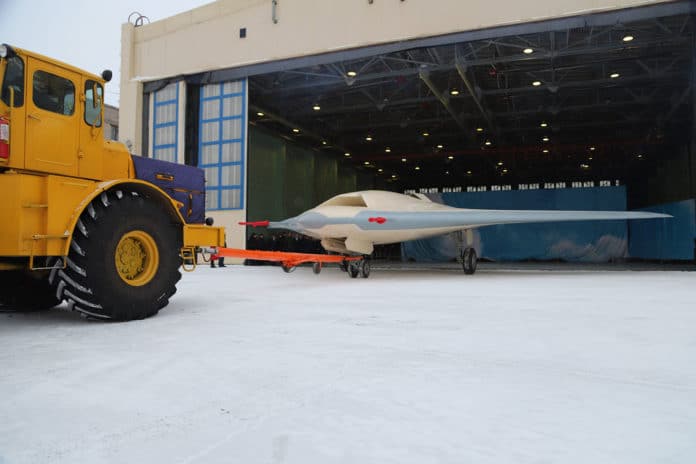United Aircraft Corporation (UAC), a subsidiary of Rostec, showed the second flying prototype of Russia’s S-70 Okhotnik unmanned combat air vehicle (UCAV). It features the long-awaited stealthier nozzle configuration, among many other refinements, that should maximize the low observability and combat effectiveness of the production version.
The heavy strike drone was rolled out at the Novosibirsk Aircraft Production Association, or NAPO, in southwestern Siberia. The preparations are underway for the drone’s debut flight, Russian Deputy Defense Minister Alexey Krivoruchko said on Tuesday.
The Okhotnik (Russian for “Hunter”) was first showcased in 2019, and at 20 tonnes, it is the heaviest drone to go into production. It has a wingspan around 65 feet (20 m) and is powered by the AL-41F turbofan that powers the Su-35 Flanker multirole fighter and initial versions of the Su-57 Felon new-generation fighter. It is made of composite materials and has a radar-absorbing coating, in addition to being equipped with electro-optical systems. On 3 August 2019, Okhotnik performed its maiden flight, which lasted more than 20 minutes.
It is not yet known whether the second prototype retains the same powerplant, but it’s obvious the engine exhaust has been entirely reworked, with the new, flat jet nozzle tailored to reduce infrared and radar signatures. This is an addition to the flying wing design (it lacks the tail) of the drone that also aims for the same effect.
The S-70 Okhotnik will be able to employ air-to-ground and air-to-air weapons, operating in conjunction with Su-57 fighter jets. The Su-57 pilot will control four latest Okhotnik heavy strike drones from the cockpit, which will be capable of hitting aerial and ground targets as part of “network-centric interaction” with the new Su-57 special two-seat version.
“The drone’s roll-out signifies the end of the item’s assembly as a whole and its outfitting with all the required onboard equipment in compliance with the requirements for aircraft and the switchover to comprehensive ground tests to prepare for its debut flight,” the deputy defense minister said.
Earlier in August, the work on the ‘Hunter’ was expected to be completed by 2022, following which the military would place orders for the delivery of these drones by 2024.
